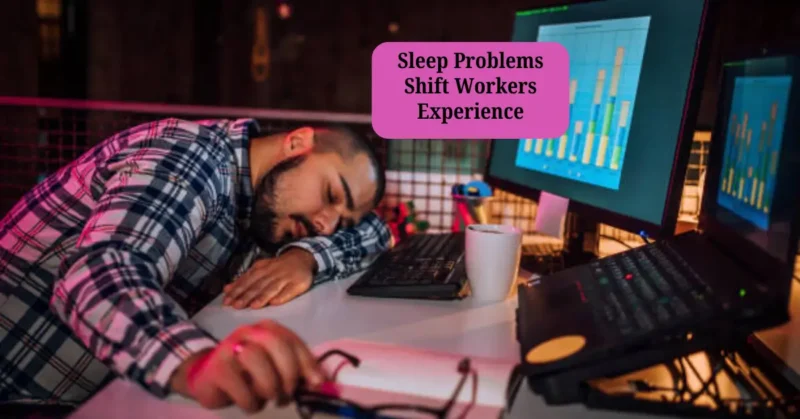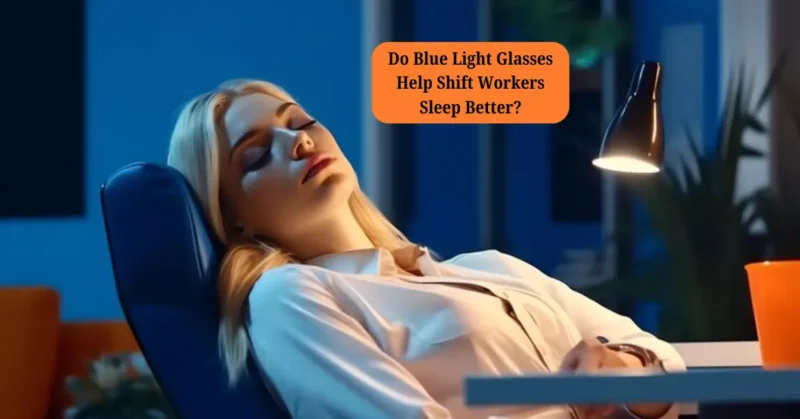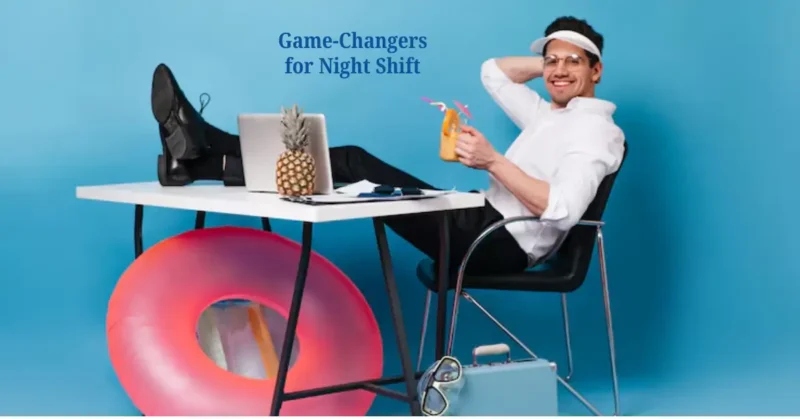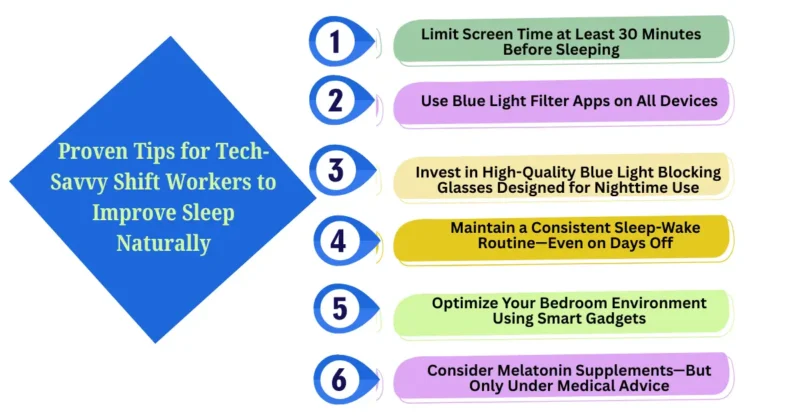Do blue light glasses help shift workers sleep better? Discover how these glasses, tech tools, and melatonin balance can improve your rest.
Thank you for reading this post, don't forget to subscribe!How Do Blue Light Glasses Help Shift Workers Sleep Better
Do you ever wonder why falling asleep after a late-night shift feels impossible, even when you’re exhausted? If you’re a tech-savvy shift worker, chances are that hours of screen time under harsh artificial light are making things worse by messing with your body’s melatonin production.
But here’s the good news: blue light glasses claim to be the simple solution that can fix your disrupted sleep cycle. But do they actually work, or are they just another tech trend?
In this post, we’ll explore how blue light exposure impacts your circadian rhythm, whether blue light-blocking technology genuinely helps improve sleep quality, and what other smart tools and gadgets are worth trying for a better night’s rest. Let’s find out if these glasses really make a difference—or if your sleep toolbox needs an upgrade.
Why Sleep is a Struggle for Shift Workers
Shift workers—especially those on night, rotating, or irregular shifts—face a serious challenge that many don’t realize: their sleep cycle is constantly at odds with their body’s natural design.
The human body follows a biological process called the circadian rhythm—an internal 24-hour clock that tells us when to feel awake and when to sleep. This rhythm is tightly linked to exposure to light and darkness. During the night, the brain signals the release of melatonin, the hormone that promotes sleepiness and prepares the body for rest.
But for shift workers, this natural process is disrupted. When you’re working under bright artificial light or staring at screens while others sleep, your brain receives mixed signals. It thinks it’s daytime, halting melatonin production—and when you finally finish your shift and want to sleep, your body remains alert, making rest feel impossible.
Most Common Sleep Problems Shift Workers Experience

Insomnia or Fragmented Sleep
Difficulty falling asleep quickly, staying asleep through the night, or waking up feeling unrested is extremely common. Even with sufficient time in bed, the quality of sleep is often poor.
Shift Work Sleep Disorder (SWSD)
A clinical condition affecting up to 30% of night and rotating shift workers. SWSD causes excessive sleepiness during work hours and severe insomnia when trying to sleep during the day. Left unmanaged, this can lead to chronic sleep deprivation.
Excessive Daytime Fatigue
Constant tiredness—even on days off—results from disrupted circadian signals. Daytime fatigue increases the risk of workplace accidents, especially in industries like healthcare, transportation, and manufacturing.
Cognitive Impairment & Mood Swings
Poor sleep quality negatively affects memory, concentration, and decision-making ability. Mood disturbances such as irritability, depression, and anxiety are also far more prevalent among night shift workers.
Higher Risk of Long-Term Health Problems
Studies show that chronic circadian disruption raises the risk of obesity, diabetes, cardiovascular disease, and even certain cancers in long-term shift workers.
The Blue Light & Artificial Lighting Problem
One of the biggest modern culprits worsening sleep for shift workers is excessive blue light exposure. Found in the LED lights of workplaces, smartphones, laptops, and tablets, blue light directly suppresses melatonin production, telling the brain it’s daytime even when the clock says midnight.
As a result:
- Melatonin release is delayed, making it difficult to feel naturally sleepy after a shift.
- The body’s core temperature and metabolism remain elevated, preventing deep sleep.
- Even when sleep does occur, REM and slow-wave sleep phases may be reduced, leaving workers feeling groggy and unrefreshed.
This is why tools like blue light-blocking glasses, filter apps, and smart lighting gadgets are becoming essential parts of a tech-savvy shift worker’s sleep routine.
The Science of Blue Light and Melatonin Suppression
What is Blue Light, and Where Does It Come From?
Blue light is a high-energy, short-wavelength light on the visible spectrum that humans are exposed to every day. Naturally, this type of light comes from the sun and plays an essential role in regulating the body’s circadian rhythm, helping to boost alertness, reaction time, and mood during daylight hours.
However, in today’s digital world, artificial blue light is everywhere:
- Smartphones and tablets
- Computer and laptop screens
- LED light bulbs
- Flat-screen TVs
- Smartwatches and fitness trackers
While this artificial blue light mimics daylight, exposure to it during the evening or nighttime disrupts the body’s natural readiness for sleep.
How Blue Light Disrupts Sleep Physiology
When your eyes receive blue light signals after dusk, your brain mistakenly believes it’s still daytime. It delays the brain’s secretion of melatonin, the hormone that controls sleep-wake cycles.
Research shows that blue light exposure between 9 PM and midnight can reduce melatonin production by up to 50%, delaying the body’s ability to feel drowsy. The consequences are far-reaching:
- Difficulty falling asleep (increased sleep latency)
- Reduced deep sleep and REM sleep stages
- Increased nighttime awakenings
- Lighter, less restorative sleep overall
This melatonin suppression also leads to a phase shift in the circadian rhythm, pushing the body’s natural sleep time later into the night, even after your shift has ended.
Why Shift Workers Are Especially at Risk
For night-shift, rotating, and early-morning shift workers, blue light exposure is practically unavoidable:
- Bright hospital lights, factory lighting, or office LEDs during overnight shifts
- Glancing at smartphones on break times or during commutes
- Using laptops or TVs after a long night shift to relax
This constant artificial light exposure confuses the brain’s clock, keeping melatonin suppressed when shift workers need it most, right after they finish work and are trying to rest.
Additionally:
- Morning light exposure during the commute home can further delay sleep by signaling the brain to “wake up” again.
- Many shift workers use devices like tablets or phones in bed to unwind, which continues the cycle of melatonin suppression and circadian misalignment.
- Prolonged light exposure reduces total sleep time, making shift workers more vulnerable to Shift Work Sleep Disorder (SWSD), fatigue, irritability, and reduced performance.
Emerging Solutions for Blue Light Management in Shift Workers
- Blue light-blocking glasses filter out harmful wavelengths, protecting melatonin production even under bright lights.
- Blue light filter apps such as f.lux and Night Shift adjust screen color temperatures to reduce disruption.
- Using smart bulbs that automatically dim in the evening helps create a body-friendly lighting environment, signalling it’s time to wind down.
Do Blue Light Glasses Really Help Shift Workers Sleep Better?
Blue light-blocking glasses, also known as blue light filter glasses, are designed to reduce the exposure of your eyes to short-wavelength blue light emitted by screens and LED lighting. These glasses feature special lenses that either partially or fully block blue light in the 400–500 nm range—the most disruptive to melatonin production and sleep quality.

For shift workers who spend hours under bright artificial lights or digital screens, these glasses are marketed as an easy solution to reduce circadian rhythm disruption and promote healthier sleep, even after intense screen time.
What Science Says About Blue Light Blocking Glasses
Multiple peer-reviewed studies and sleep science experiments indicate that blue light-blocking technology offers several proven benefits:
Reduced Melatonin Suppression
A 2017 study published in Chronobiology International showed that participants who wore blue light-blocking glasses in the evening maintained normal melatonin secretion, while those exposed to blue light without protection saw up to a 50% reduction in melatonin levels.
Improved Sleep Onset Time (Falling Asleep Faster)
Research from the Journal of Adolescent Health found that blue light filter glasses significantly decreased the time required to fall asleep, even after evening screen use.
Decreased Symptoms of Digital Eye Strain
Extended exposure to digital screens causes Computer Vision Syndrome (CVS), with symptoms like dry eyes, headaches, and blurred vision. Blue light glasses help reduce these symptoms by filtering high-energy visible (HEV) light, making screen viewing more comfortable during long shifts.
Real Benefits for Night Shift Workers
For tech-savvy shift workers in healthcare, IT, manufacturing, and customer support roles, these glasses can make a noticeable difference:
- Faster Sleep Onset After Shifts:
- By preserving melatonin levels even after hours of artificial light exposure, workers find it easier to fall asleep when their shifts end, helping them avoid tossing and turning for hours.
- Improved Sleep Quality and Duration:
- Blue light glasses may promote deeper and longer sleep, increasing the amount of restorative REM and slow-wave sleep, which is essential for cognitive recovery.
- Reduced Eye Fatigue and Strain:
- Constant screen exposure during overnight shifts leads to eye strain and visual discomfort. Blue light blockers relieve this by reducing glare and light scatter, especially from LED monitors and smartphones.
Factors That Influence Effectiveness
While many users report better sleep and reduced fatigue, the effectiveness of blue light glasses can vary depending on several factors:
Lens Quality & Filtering Strength:
Some cheap or fashion-oriented blue light glasses filter only 10–20% of harmful light, while medical-grade versions can block up to 99% of blue wavelengths.
Timing of Use:
Glasses are most effective when worn 2–3 hours before intended sleep time, particularly for shift workers trying to “wind down” after a night shift.
Complementary Habits:
If users continue scrolling on phones in bed or watching TV under bright room lights without dimming them, the benefits of the glasses may be reduced. Combining glasses with screen-dimming apps, reduced screen time, and smart lighting maximizes results.
Do All Blue Light Glasses Work the Same?
Not necessarily. Factors to consider include:
- Lens Tint: Amber or red-tinted lenses block more blue light but may distort color perception. Clear lenses block less but are more suitable for daytime use.
- Certification & Testing: Look for glasses that come with light transmission reports or certifications to guarantee performance.
- Frame Comfort: Shift workers often wear glasses for long hours; a poorly fitting pair may cause discomfort or headaches.
Best Tech Tools & Sleep Gadgets for Shift Workers

While blue light-blocking glasses are a powerful tool for protecting your sleep, they are just one part of the modern shift worker’s sleep toolbox. The rise of sleep technology has brought a range of innovative gadgets designed to help regulate circadian rhythms, promote relaxation, and optimize sleep quality, perfect for tech-savvy night shift workers who need help catching quality rest during unconventional hours.
1. Wearable Sleep Tracking Devices: Your Personal Sleep Coach
Wearable sleep trackers have revolutionized how we understand and improve sleep. These devices gather detailed physiological data—like sleep stages, heart rate variability (HRV), blood oxygen saturation (SpO2), and movement patterns—to provide real-time feedback on sleep quality.
Popular Wearables for Shift Workers
- Oura Ring Gen 3: Tracks body temperature, respiratory rate, and readiness scores to optimize recovery after night shifts.
- Fitbit Sense/Charge 6: Offers personalized Sleep Scores, detects stress levels, and provides guided breathing sessions to help workers unwind post-shift.
- Whoop Strap 4.0: Designed for performance optimization, it tracks recovery, strain, and sleep efficiency, offering coaching tips based on circadian readiness.
Why Important for Shift Workers?
- Detects REM and deep sleep deficiencies common in night workers.
- Helps adjust sleep and nap schedules based on real recovery data.
- Encourages mindful sleep hygiene practices based on biofeedback.
2. Blue Light Filter Apps: Digital Protection on All Your Screens
Even with blue light glasses, controlling screen emissions directly is smart. Blue light filter apps adjust your device’s color temperature, reducing the intensity of blue wavelengths emitted from screens.
Top-Rated Apps:
- f.lux: Automatically adapts your device’s display warmth based on the time of day, ideal for late-night screen exposure.
- Iris: Offers advanced manual controls over screen brightness, color warmth, and blue light levels for optimal customization.
- Night Shift (iOS) & Night Mode (Android): Built-in features that reduce HEV (high-energy visible) light to minimize melatonin disruption during night shifts.
Benefits for Shift Workers:
- Reduces eye strain and mental alertness at the wrong times.
- Complements blue light glasses for double-layer protection.
- Helps prepare the body for sleep when using devices post-shift.
3. Smart Sleep Aids: High-Tech Solutions for Better Rest
Modern sleep tech isn’t just about screens—smart sleep aids can transform your entire sleep environment.
Must-Have Smart Sleep Tools:
- White Noise Machines: Devices like LectroFan EVO or Yogasleep Dohm create consistent, soothing sounds to block disruptive noises (especially useful for daytime sleep after night shifts).
- Sunrise & Sunset Simulation Lamps: Products like Philips SmartSleep simulate dawn and dusk, helping reset circadian rhythms naturally—even when waking at odd hours.
- Smart Dimming Bulbs: Brands like LIFX and Philips Hue offer bulbs that gradually dim or brighten based on custom sleep/wake schedules, promoting natural melatonin release.
Why Do They Matter for Shift Workers?
- Improves sleep environment for daytime sleepers.
- Simulates natural light cues to help regulate a disrupted biological clock.
- Reduces reliance on stimulants or sleep medications.
4. Sleep Optimization Tools: Temperature Tech for Deeper Sleep
Temperature regulation is a critical yet often overlooked factor in sleep quality. For shift workers struggling with daytime heat or cold nighttime environments, smart sleep tools can make a world of difference.
Top Sleep Optimization Gadgets:
- Eight Sleep Pod Cover: A smart mattress system that adjusts bed temperature individually for each side, perfect for people with varying comfort needs.
- ChiliPAD Cube & Dock Pro: Delivers precise cooling or heating to maintain the ideal sleep temperature throughout the night.
- Cooling Pillows: Options like the Tempur-Pedic Breeze Pillow or Sleep Number’s True Temp Pillow stay cool and wick moisture to reduce discomfort during restless nights.
Why Temperature Control Matters for Shift Workers?
- Promotes longer periods of slow-wave (deep) sleep.
- Reduces nighttime awakenings caused by discomfort or overheating.
- Supports recovery by keeping the core body temperature stable, which is essential for sleep quality.

Why These Tech Tools Are Game-Changers for Night Shift Workers
Combining these gadgets with blue light-blocking glasses creates a comprehensive, technology-driven sleep strategy tailored for modern shift workers. From controlling light exposure to monitoring sleep cycles and regulating room environment, these tools offer a science-backed approach to combat Shift Work Sleep Disorder (SWSD) and ensure deep, restorative sleep—even after the longest overnight shifts.
Blue Light Glasses vs. Other Sleep Solutions: Which Works Best?
| Solution | Pros | Cons |
|---|---|---|
| Blue Light Glasses | Non-invasive, wearable, blocks light instantly | Needs consistent use; quality varies |
| Melatonin Supplements | Boosts melatonin levels directly | Risk of grogginess, dependency |
| Blue Light Filter Apps | Free or low-cost, easy to install | Can’t block all blue light sources |
| Tech Sleep Aids (Wearables, Gadgets) | Personalized data, comprehensive solutions | Expensive upfront costs |
Pro Tip:
Combining blue light glasses with sleep hygiene tools and wearables can yield the best results.
Proven Tips for Tech-Savvy Shift Workers to Improve Sleep Naturally

1. Limit Screen Time at Least 30 Minutes Before Sleeping
One of the simplest but most powerful strategies for better sleep is reducing screen exposure at least 30–60 minutes before bedtime. Screens from smartphones, tablets, laptops, and even TVs emit high-energy visible (HEV) blue light that interferes with melatonin production.
Why This Matters for Shift Workers:
- Night shift workers are prone to using devices after work to relax, scrolling social media or watching videos, which prolongs alertness.
- Cutting off-screen time allows the brain to initiate natural sleep onset processes, signalling melatonin release and lowering cortisol levels (the “stress hormone” that keeps you awake).
Pro Tip: Switch to relaxing activities such as audiobooks, meditation, or journaling before bed.
2. Use Blue Light Filter Apps on All Devices
When avoiding screens isn’t possible, tech solutions like blue light filter apps can help mitigate damage. These apps reduce the short-wavelength blue light emission by warming the screen’s color temperature.
Popular and Effective Options:
- f.lux (PC/Mac): Adjusts display warmth based on local sunrise and sunset times.
- Night Shift (iOS) & Night Mode (Android): Built-in settings to reduce eye strain during night use.
- Iris (Windows/macOS/Linux): Customizable filters that minimize blue light and flicker.
- Shift Worker Benefit: Helps reduce eye fatigue, digital eye strain (DES), and sleep latency without giving up necessary device usage during off-hours.
3. Invest in High-Quality Blue Light Blocking Glasses Designed for Nighttime Use
Not all blue light glasses are created equal. For maximum sleep benefits, shift workers should choose night-specific glasses that block 90–99% of harmful blue light, especially in the 400-500nm wavelength range.
What to Look For:
- Amber or red-tinted lenses for full nighttime protection.
- Verified lab reports showing light transmission reduction data.
- Comfortable, adjustable frames for prolonged wear during shifts.
Avoid fashion-only glasses that offer minimal protection but advertise blue light blocking.
4. Maintain a Consistent Sleep-Wake Routine—Even on Days Off
Your body’s circadian rhythm thrives on consistency. For shift workers, this can be not easy, but maintaining a set bedtime and wake-up time daily (even on weekends or off-days) helps anchor your internal clock.
Why It’s Crucial:
- Prevents “social jet lag,” where your body struggles to readjust after days off.
- Reduces the risk of Shift Work Sleep Disorder (SWSD).
- Helps melatonin production and cortisol rhythms remain predictable.
Use wearable trackers (like Fitbit or Oura Ring) to monitor consistency and receive personalized sleep score feedback.
5. Optimize Your Bedroom Environment Using Smart Gadgets (Lighting, Sound & Temperature)
Creating a high-tech sleep sanctuary is essential, especially for workers trying to sleep during the day.
Recommended Smart Gadgets:
- Smart Bulbs (Philips Hue, LIFX): Simulate sunset to encourage melatonin production and provide gradual morning wake-ups.
- White Noise Machines (Dohm, LectroFan): Mask daytime noise and promote deep sleep stages like slow-wave sleep.
- Smart Thermostats (Nest, Ecobee): Maintain ideal room temperature (60–67°F) proven to support sleep quality.
- Cooling Pillows and Mattress Toppers (Eight Sleep, ChiliPAD): Regulate bed temperature for uninterrupted rest.
Bonus Tip: Install blackout curtains and avoid LED alarm clocks to eliminate light pollution.
6. Consider Melatonin Supplements—But Only Under Medical Advice
While melatonin supplements can help shift workers fall asleep faster, they’re not without risks. Misuse may lead to hormonal dependency, drowsiness during shifts, or reduced natural melatonin production.
When to Use Melatonin Supplements:
- When adjusting to a new shift rotation.
- Long flights or jet lag affects sleep cycles.
- Under doctor supervision for managing SWSD symptoms.
Dosage Tip: Most experts recommend 0.5mg to 3mg, taken 30–60 minutes before bedtime—not the common, but excessive 5–10mg doses found in over-the-counter options.
Natural Alternatives: Consider chamomile tea, valerian root, or magnesium supplements for sleep support without hormones.
FAQs on Blue Light Glasses
Q. Should I wear blue light glasses on the night shift?
Yes, wearing blue light-blocking glasses during night shifts is highly recommended, especially if you spend long hours under LED lighting or staring at digital screens. These glasses filter out the high-energy blue wavelengths that disrupt melatonin production and your circadian rhythm. By reducing exposure to artificial light, they help your body stay better prepared for sleep when the shift ends.
Blue light glasses may also reduce digital eye strain, headaches, and visual fatigue, which are common among night workers. For maximum benefit, choose glasses designed specifically for nighttime use. Remember to combine them with screen-dimming apps and good sleep hygiene. It creates a complete defence against sleep disruption during night shifts.
Q. What are the best glasses for night shift workers?
The best blue light-blocking glasses for night shift workers are those that block 90–99% of blue light, especially within the 400–500 nm wavelength range. Brands like Swanwick, TrueDark, Felix Gray, and Gunnar Optiks offer high-performance options with scientifically tested lenses. Amber or red-tinted lenses provide maximum nighttime protection by filtering nearly all blue light, which is ideal for post-shift winding down.
Ensure the glasses come with verified light transmission reports or certifications for effectiveness. Comfort is also important, as shift workers may wear them for extended periods. Adjustable, lightweight frames reduce strain on the nose and ears. A well-fitted, high-quality pair ensures better sleep quality after late shifts.
Q. Do blue light glasses help at work?
Yes, blue light glasses can be highly beneficial during work hours, especially for shift workers exposed to prolonged digital screens or bright office lighting. These glasses help reduce eye strain, blurred vision, and headaches caused by high-energy visible (HEV) light from monitors, tablets, and smartphones.
While they protect against eye discomfort, they also help minimize melatonin disruption if worn close to the end of the shift. It can make falling asleep after work easier by ensuring less blue light exposure. Glasses with mild tinting are perfect for daytime screen work, while stronger amber lenses suit nighttime protection. When combined with screen filter apps, their effectiveness increases further. They offer both visual comfort and long-term sleep benefits.
Q. Can blue light improve sleep? What’s the best combination of sleep tools for shift workers?
While natural blue light exposure in the morning can boost alertness and reset your circadian rhythm, artificial blue light at night usually harms sleep by suppressing melatonin. Therefore, reducing blue light exposure before bed improves sleep quality, especially for shift workers. The best sleep tool combination includes blue light-blocking glasses, wearable sleep trackers (like Fitbit or Oura), smart dimmable lights, and white noise machines.
Together, these tools help regulate melatonin production, reduce distractions, and create an ideal sleep environment. Consistent sleep-wake timing, even on off days, is also key. For maximum benefit, avoid late-night screen use and optimize bedroom temperature. This holistic approach supports deep, restorative sleep despite shift work demands.
Q. Can tech gadgets replace melatonin supplements?
Tech gadgets like blue light-blocking glasses, sunrise simulation lamps, and smart sleep trackers can significantly improve sleep quality and help regulate circadian rhythms naturally. However, they may not completely replace the need for melatonin supplements, especially for those with diagnosed Shift Work Sleep Disorder (SWSD) or severe jet lag.
Melatonin supplements provide direct hormonal support when natural melatonin production is disrupted, but they must be used carefully under medical supervision. In contrast, tech tools promote natural melatonin release without hormonal intake. Combining these gadgets with healthy sleep habits often reduces the need for supplements.
Long-term, non-pharmacological methods are preferred for safety and sustainability. Always consult a healthcare provider before relying solely on supplements.
Q. Do blue light glasses really regulate circadian rhythms?
Blue light glasses can help regulate your circadian rhythm by blocking harmful blue wavelengths that suppress melatonin production, especially during night shifts or late-evening screen use. By reducing blue light exposure in the hours before sleep, these glasses signal to the brain that it’s time to start producing melatonin, thus supporting a natural sleep-wake cycle.
However, they are most effective when combined with other strategies like reducing overall screen time and using warm lighting in the environment. Alone, they cannot fully “reset” the circadian clock but are a valuable tool in protecting its rhythm from modern light pollution. For shift workers, this means easier sleep onset and deeper sleep quality. Consistent use is key for lasting circadian benefits.
Conclusion: Are Blue Light Glasses Worth It for Shift Workers?
For tech-savvy shift workers struggling with sleep, blue light glasses offer a promising, science-backed solution to minimize melatonin disruption and improve rest. However, they work best when combined with other sleep optimization tools, such as wearable trackers, blue light filter apps, and smart sleep aids.
If you’re serious about protecting your health and staying energized for your shifts, investing in the right blue light-blocking technology and sleep gadgets could transform your sleep quality and overall well-being. Combining these practical habits and smart tech tools allows shift workers to regain control over their circadian health and avoid the dangerous long-term effects of sleep disruption. By managing blue light exposure, optimizing the sleep environment, and maintaining a routine, even the most demanding night schedules can feel less exhausting and more sustainable.
Read more Health and Wellness Tips.
You might like:

